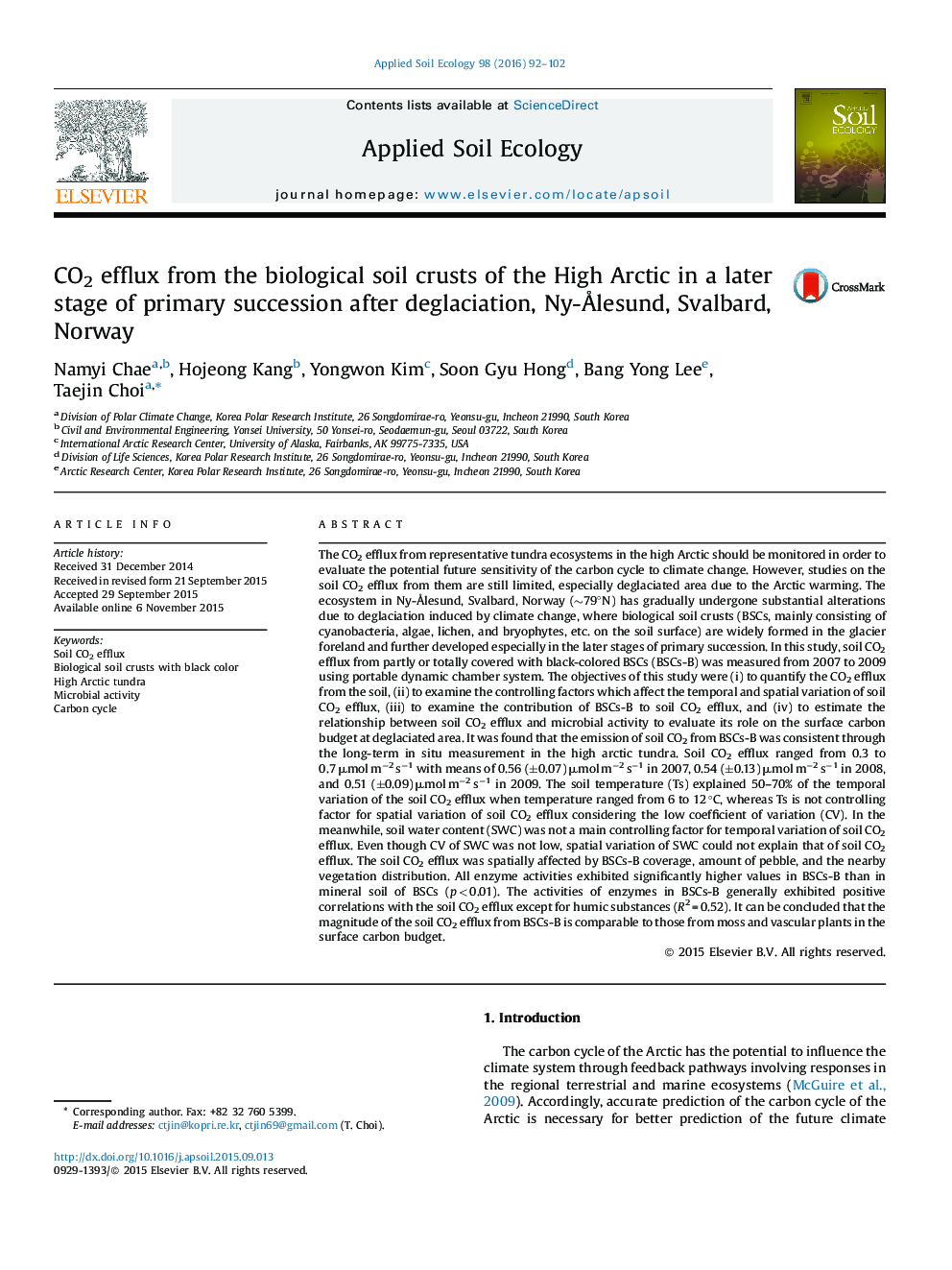| کد مقاله | کد نشریه | سال انتشار | مقاله انگلیسی | نسخه تمام متن |
|---|---|---|---|---|
| 4381861 | 1617785 | 2016 | 11 صفحه PDF | دانلود رایگان |

• We measured not-well known soil CO2 efflux from BSCs with black color during summer.
• The coverage and quality of BSCs-B affected the spatial variation of soil CO2 efflux.
• The soil CO2 efflux showed positive correlations with the enzyme activities in BSCs-B.
• The measured soil CO2 efflux significantly contributed to the surface carbon budget.
The CO2 efflux from representative tundra ecosystems in the high Arctic should be monitored in order to evaluate the potential future sensitivity of the carbon cycle to climate change. However, studies on the soil CO2 efflux from them are still limited, especially deglaciated area due to the Arctic warming. The ecosystem in Ny-Ålesund, Svalbard, Norway (∼79°N) has gradually undergone substantial alterations due to deglaciation induced by climate change, where biological soil crusts (BSCs, mainly consisting of cyanobacteria, algae, lichen, and bryophytes, etc. on the soil surface) are widely formed in the glacier foreland and further developed especially in the later stages of primary succession. In this study, soil CO2 efflux from partly or totally covered with black-colored BSCs (BSCs-B) was measured from 2007 to 2009 using portable dynamic chamber system. The objectives of this study were (i) to quantify the CO2 efflux from the soil, (ii) to examine the controlling factors which affect the temporal and spatial variation of soil CO2 efflux, (iii) to examine the contribution of BSCs-B to soil CO2 efflux, and (iv) to estimate the relationship between soil CO2 efflux and microbial activity to evaluate its role on the surface carbon budget at deglaciated area. It was found that the emission of soil CO2 from BSCs-B was consistent through the long-term in situ measurement in the high arctic tundra. Soil CO2 efflux ranged from 0.3 to 0.7 μmol m−2 s−1 with means of 0.56 (±0.07) μmol m−2 s−1 in 2007, 0.54 (±0.13) μmol m−2 s−1 in 2008, and 0.51 (±0.09) μmol m−2 s−1 in 2009. The soil temperature (Ts) explained 50–70% of the temporal variation of the soil CO2 efflux when temperature ranged from 6 to 12 °C, whereas Ts is not controlling factor for spatial variation of soil CO2 efflux considering the low coefficient of variation (CV). In the meanwhile, soil water content (SWC) was not a main controlling factor for temporal variation of soil CO2 efflux. Even though CV of SWC was not low, spatial variation of SWC could not explain that of soil CO2 efflux. The soil CO2 efflux was spatially affected by BSCs-B coverage, amount of pebble, and the nearby vegetation distribution. All enzyme activities exhibited significantly higher values in BSCs-B than in mineral soil of BSCs (p < 0.01). The activities of enzymes in BSCs-B generally exhibited positive correlations with the soil CO2 efflux except for humic substances (R2 = 0.52). It can be concluded that the magnitude of the soil CO2 efflux from BSCs-B is comparable to those from moss and vascular plants in the surface carbon budget.
Journal: Applied Soil Ecology - Volume 98, February 2016, Pages 92–102